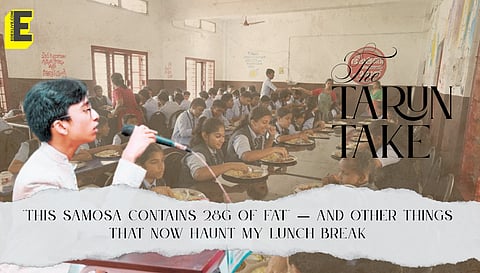

It started with a laminated board near the cafeteria counter at my friend’s school.
“Samosa — 28g Fat | Bread Pakora — 25g Fat | Chips (Large) — 35g Fat | Poha — 9g Fat.”
There it was, in bold, right above the cashier’s head. And just like that, lunchtime in Indian schools became a nutritional math class.
Last week, CBSE issued new directions to affiliated schools across the country to install “oil boards” in school cafeterias, a visual reminder of just how much fat we're consuming with every deep-fried bite.
I study in a private CBSE school in Odisha, and within days, our tiny food counter transformed into what I can only call a calorie courtroom.
I saw our samosa bhaiyya — always smiling, always generous with the green chutney — glance up at the new board with a sheepish shrug. “Ab toh sabko pata chal gaya, beta,” he muttered when I ordered. I smiled back, pretending I wasn’t calculating whether 28 grams of fat was closer to an hour of PT or two.
The idea behind these boards, according to the circular, is to raise health awareness. And in theory, it makes sense. We’ve all heard lectures on junk food.
We’ve seen WhatsApp forwards about how sugar is the new poison. But this was the first time my friends and I were being confronted with real, numerical guilt. There’s something startlingly adult about being asked to quantify your indulgence.
Some of my classmates took it seriously. "I’m switching to poha," declared Abhinav, who had recently started counting steps and watching fitness reels on Instagram. Rishit, on the other hand, stuffed a chip packet into his hoodie sleeve and whispered, “The board never said anything about contraband.”
I couldn’t help but notice: while the oil board spoke volumes, our cafeteria didn’t yet offer many healthy alternatives. One could either eat the fat-heavy samosa or... walk away.
The “fruit salad” was more legend than lunch item — perpetually out of stock. That’s when I realised: information without infrastructure is just intention.
Teachers have applauded the move. Our Biology teacher linked it to our nutrition chapter and even suggested we write reflective pieces on our food habits for the school magazine.
The GK teacher floated an idea of a weekly “Cafeteria Fact File” — a student-led initiative to track how food habits are changing. It’s a great start, but I wonder — will this awareness last beyond the initial novelty?
There’s another layer too — peer pressure.
In middle school and early high school, food isn’t just food. It’s identity. The kid who eats sprouts is “trying too hard.” The one who orders two samosas is “so relatable.”
Our choices at lunch can make or break social dynamics, and now that a board announces those choices with scientific accuracy, a quiet moral judgement has entered the cafeteria.
Some students hesitate before picking up a samosa, glancing at the board, then at their friends. Others weaponise the information: “Dude, you just ate 35 grams of fat!”
We talk a lot about raising awareness, but sometimes, it turns into quiet shaming. And I wonder if, in trying to create informed eaters, we are also — unintentionally — creating anxious ones.
But still, something’s changing. My younger cousin in Class 6 drew a cartoon for the school wall-magazine of a samosa lifting weights, saying, “I’m too heavy.”
It was funny, clever, and revealed how the oil board had already seeped into the imagination of students. That, I think, is the real impact: not instant calorie control, but conversation.
Parents, of course, are divided. My mother thinks it’s a good thing — “At least now you’ll think twice before junk,” she said. My father, who lovingly fries papads every Sunday, laughed, “Just wait till they start putting ‘oil boards’ on our dinner table.”
In the end, I don’t think the oil board is about fat grams. It’s about visibility.
For the first time, students are being trusted with real-time data about what they consume. It may be messy, it may trigger silent comparisons, it may not immediately change our habits — but it’s a start.
Because in a country where childhood obesity and diabetes are rising, and yet cafeteria menus are rarely questioned, perhaps a quiet board above a samosa tray is more revolutionary than it seems.
But for the oil board to truly work, it must be followed up with better options, student-led awareness projects, nutrition-linked learning, and — most importantly — kindness. The goal isn’t to demonise food. The goal is to understand it.
So, tomorrow, when I stand in line and see “Poha — 9g Fat” glowing gently in whiteboard marker, I may just go for it.
Or maybe, just maybe, I’ll still get the samosa — but skip the chips. And that, I suppose, is still a win.
(Tarun Tapan Bhuyan is a student of SAI International School. Views expressed are his own.)
